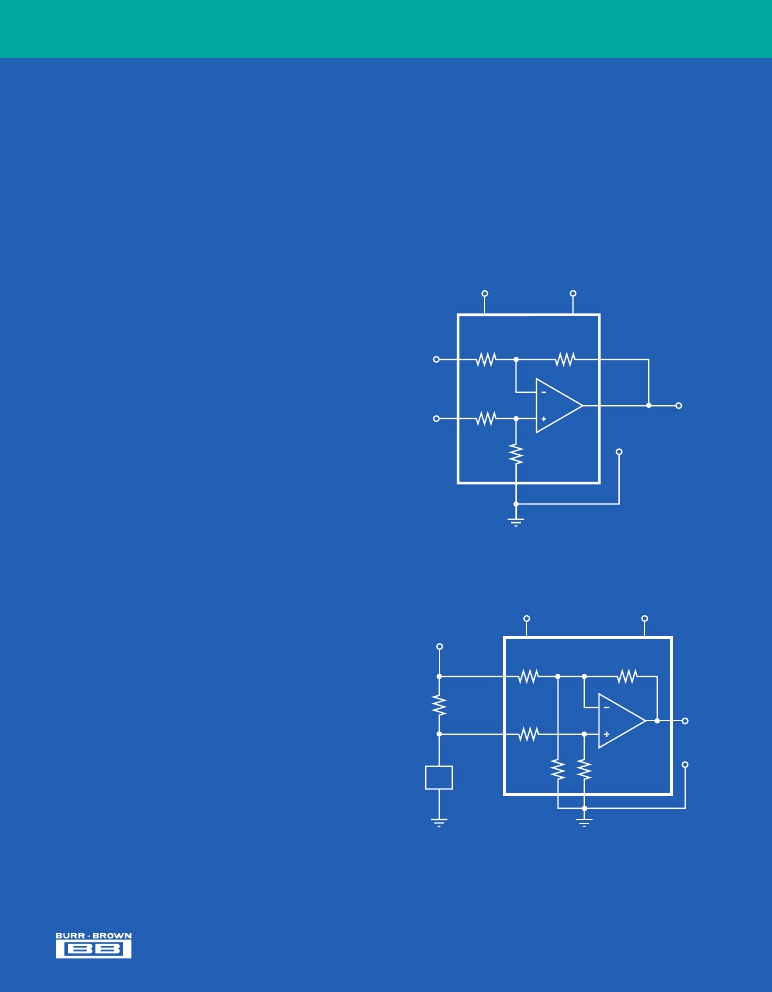- 您現(xiàn)在的位置:買賣IC網(wǎng) > PDF目錄369495 > BROCHURE Brochure - Signal Acquisition - Instrumentation Amplifier Brochure PDF資料下載
參數(shù)資料
| 型號: | BROCHURE |
| 元件分類: | 測量放大器 |
| 英文描述: | Brochure - Signal Acquisition - Instrumentation Amplifier Brochure |
| 中文描述: | 樣本-信號采集-儀表放大器手冊 |
| 文件頁數(shù): | 6/12頁 |
| 文件大小: | 492K |
| 代理商: | BROCHURE |

D
Difference Amplifiers
The difference amplifier is a closed–loop fixed–gain block that allows the acquisition of signals in the presence
of ground loops and noise. These versatile devices can be used in a wide variety of circuit configurations.
Burr-Brown offers difference amplifiers for precision general purpose, audio, low power high speed and high common-mode
voltage applications. Also available are dual difference amplifiers—saving space and reducing cost per channel.
Difference Amplifier Topology
The basic difference amplifier employs an op amp and four
on-chip precision matched resistors.
The
INA132
operates on a single 2.7V to 36V supply and
consumes only 160μA. It can be configured to provide a
differential gain of 1 or –1, or single-ended gains of +1, –1,
+1/2, or –1/2.
The output signal is referenced to the Ref pin which is generally
grounded. The output sense pin can be connected at the load to
reduce gain error.
Since the resistor network divides down the input voltages,
difference amplifiers can operate with input signals that exceed
the power supplies.
INA132
R
1
40k
V–
Sense
V+
V
2
V
OUT
= V
3
– V
2
V
3
R
2
40k
R
3
40k
R
4
40k
Ref
–15V
–In = V
2
+In = V
3
+15V
±
200V
Load
Shunt
Resistor
V
OUT
= V
3
– V
2
R
1
380k
R
3
380k
R
5
21.1k
R
2
380k
R
4
20k
INA117
High Voltage Difference Amplifier
A five-resistor version of the simple difference amplifier results
in a device that can operate with very high levels of
common–mode voltage—far beyond the power supply rails.
The
INA117
can sense differential signals in the presence of
common–mode voltages as high as ±200V while being powered
from ±15V.
This device is very useful in measuring current from a high
voltage power supply through a shunt resistor.
Burr-Brown Corporation
www.burr-brown.com
相關(guān)PDF資料 |
PDF描述 |
|---|---|
| BRT12H | Super Fast Rectifier Diodes |
| BRT12M | Super Fast Rectifier Diodes |
| BRT13H | Super Fast Rectifier Diodes |
| BRT13M | Optoelectronic |
| BRT12 | Optocoupler, Phototriac Output |
相關(guān)代理商/技術(shù)參數(shù) |
參數(shù)描述 |
|---|---|
| BROKEN BOX CHARGE | 制造商:ETRI 功能描述: |
| BROKER FEE | 制造商:Aavid Thermalloy 功能描述:- Bulk |
| BRONZE | 制造商:Brady Corporation 功能描述:BRONZE INSTALL |
| BRONZE UNIKIT | 制造商:NOGA 功能描述:DEBURRING KIT 13-PC 制造商:NOGA 功能描述:DEBURRING KIT, 13-PC |
| BROS100-22-LSO | 制造商:VESTAL 制造商全稱:VESTAL 功能描述:Bare Radial Jumper Wire With OS Crimp |
發(fā)布緊急采購,3分鐘左右您將得到回復(fù)。